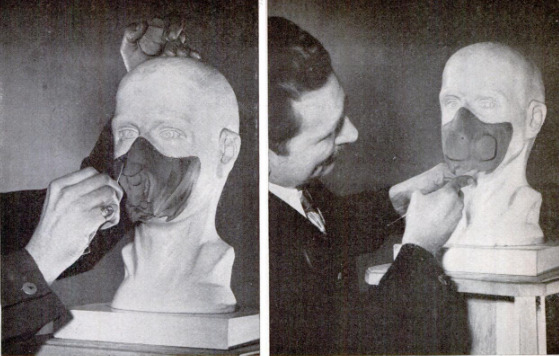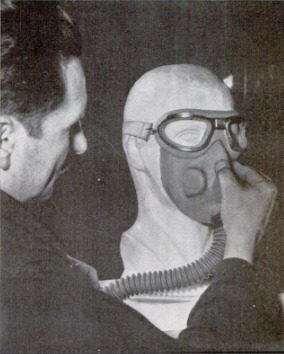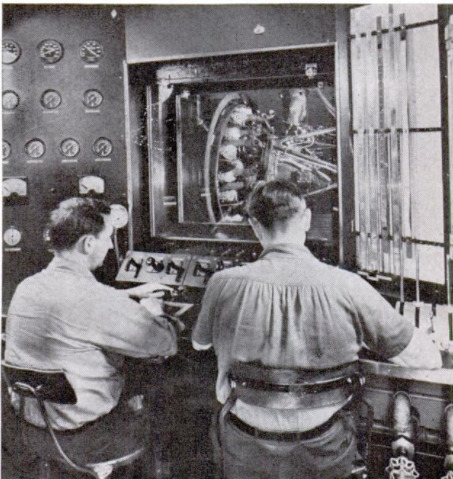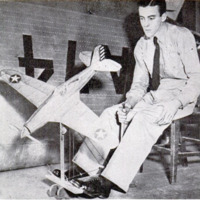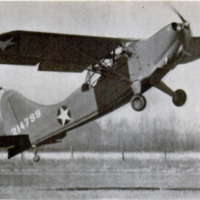-
Title (Dublin Core)
-
The typical American flyers
-
Article Title and/or Image Caption (Dublin Core)
-
Title: Anthropology shows you the typical American flyers
-
extracted text (Extract Text)
-
SHORTLY after America entered the war it was
discovered, in the testing of an experimental
bombing plane, that while a flyer of average size
could easily squeeze through the escape hatch to
bail out of the ship, a big flyer could not possibly
make a jump without first taking off his parachute.
The hatch had been made too small.
This embarrassing “bug” was immediately cor-
rected by the manufacturer, but meanwhile it had |
performed an immensely useful service. It had em- |
phasized and dramatized an important fact which
was beginning to be realized at the Aero-Medical
Research Laboratory at Wright Field: designers of
flying equipment did not have enough precise knowl-
edge of the shape and size of the young men who
were going to use it.
To avoid trespassing on the flyers’ physi-
cal limitations, as designers strained to
make the best use of every ounce and inch
of an airplane, it became more and more
important to have such knowledge.
In one special fleld it was immediately
and urgently needed—the design of oxygen
masks for high-altitude flying. This kind
of flying has been made possible by m-
provement in oxygen equipment no less
than by development of engines and planes;
but the masks in use are still far from per-
fect, even though the late models are
guarded as prime military secrets. One
great problem is to design a mask, prefer-
ably not of rubber, which can be turned out
by mass production in as few sizes as pos-
sible and will operate with a minimum of
leakage on the great variety of faces to be
found on the thousands of fiyers in the
Air Forces,
When Thunderbolt meets Messerschmitt
at 30,000 feet, a mere one-percent advan-
tage in mask efficiency may well mean the
difference between victory and death. And
mask efficiency is a matter of anatomy.
Col. Otis O. Benson, Jr. chief of the
Aero-Medical Laboratory, consulted Prof.
Earnest A. Hooton, the noted physical an-
thropologist of Harvard University, and
together they worked out a program of re-
search aimed to classify the physical char-
acteristics of the American flyer. Hooton
picked out four of his star students, ex-
perts at using slide calipers, spreading
calipers, anthropometers, and other pre-
cisely scaled instruments for measuring the
topography of the human body. Last Feb-
ruary they set to work in two teams at Air
Force replacement centers, making detailed
studies of the heads, limbs, and bodies of the
young men entering the Air Forces.
Today the first tangible results of that
study are embodied in seven sculptured
heads, representing precisely measured
composites of all the types of faces found
among 1,871 young men. Graduated from
long to short, the seven heads present a
graphic demonstration of the broad range
required in a satisfactory form-fitting oxy-
gen mask.
Since autumn, plaster replicas of these
seven heads have been in service in the de-
signing rooms of all manufacturers of
oxygen equipment, serving as embodied
specifications. Varied as the faces may
seem, they actually represent a simplifica~
tion of the problem, for in relation to the
physiognomy of the people as a whole,
flyers run pretty much to type. Earlier
advances in mask design were made almost
entirely by medical doctors who, lacking
any large group of aviators as models, tried
out their devices on the faces of hospital
patients. Obviously the air force cadets,
selected for youth and physical fitness, will
have a different range of facial contours
from any collection of invalids.
Engineers working on mask design are
able to mold their experimental masks di-
rectly on the faces of the plaster casts,
knowing that with certain allowances for
flexibility they can fit almost anybody in
the air force.
Dominant among the seven heads is the
central figure, designated as Head I, repre-
senting the average flyer, the grand mean
of all the measurements taken from the
1,871 specimens. By luck rather than by
artistic intent, he turned out to be the best-
looking one of the lot, with a strange re-
semblance to both the Prince of Wales and
the Arrow Collar Man as they appeared in
the early 1020's. As the composite of the
youngsters who have just lately been get-
ting their wings, he is the American Flyer:
1943 Model.
The creation of these heads, which is |
merely the first step in the building of life-
size manikins embodying airmen’s physical
characteristics, represents a fortuitous
blending of practical engineering and pure
science. They are the result of the collab-
oration of the young man who is probably
America’s foremost expert on the anatomy
of the gorilla, and the plastics-industry pio-
neer who invented the “Frank Buck hat,” |
now the standard tropical helmet for the
American and British armies.
By last July, when the statistical analysis
of all the measurements was complete, the
anthropology team had dwindled to one
man, now a second lieutenant in the Air |
Forces, 20-year-old Dr. Francis E. Randall,
from New Philadelphia, Ohio. At Western
Reserve University, Randall had specialized
in comparative anatomy, working With |
Prof. T. Wingate Todd, who had the great-
est collection of gorilla skeletons in this
country. When Todd died, Randall con-
tinued his work. When the Japs struck at
Pearl Harbor, he was just putting the finish-
ing touches on his Harvard Ph. D. thesis, on
“Growth in Gorillas.” One gathers, talking
with him, that Randall felt pretty much |
out of things, as though his specialty were
far from wartime realities. But no sooner
had he finished his studies than the Army
grabbed him, to put his special training to |
work on the quest for the perfect mask.
When Lieutenant Randall presented his |
report last summer, senior officers looked at
it with a blank, bewildered stare. It com-
prised numerous closely typed pages of
little else but figures, about as intelligible
as Egyptian hieroglyphic. |
“Now you've got it, what are you going to
dowith i?" a general finally managed to say.
The men at Aero-Medical had a quick an-
swer. Turn these figures into sculptured
figures. The value of such figures was al-
ready apparent. At Wright Field they had
been using, as a model for trying out
assemblies of mask, goggles, earphones, and
helmet, an aluminum head which a sculptor
had made for the purpose. It was a good,
anatomical head of an individual, but
‘measurement now showed it to be far from
the norm of the Army aviator of today.
The thing to do was get a sculptor quick.
A noted sculptor was called on the long-
distance phone. How quickly could he pro-
duce five heads, made to measure? The
artist said it would take at least two
months; he couldn't do it a bit sooner. The
Army reluctantly said he wouldn't do. They
had to have speed.
Then a Wright Field engineer spoke up.
He knew a business man in Chicago who he
thought could do the job, G. Walter Bork-
land, president of the General Plastics Cor-
poration. As a sculptor Borkland was only
a talented amateur, who practiced the art
as a hobby, but he was a professional with
modeling clay. He was in the habit of de-
signing such things as transparent plastic
lighting fixtures, rapidly and strictly to
specification. He was ingenious, as shown
by his develop.
ment of a featherweight plastic sun helmet,
with a patent suspension that made one size
fit almost any man’s head. Moreover, he had
specialized for the last year in efforts to
design a satisfactory oxygen mask from
molded plastic. He knew the problem, and
would tackle it enthusiastically. He was
called on the telephone and told that he
was selected to make the heads, and make
them quick.
Lieutenant Randall hurried to Chicago
with his figures. In 16 working hours, with
Randall checking the measurements and
supplying anatomical criticism, Head I was
completed. In a little more than two weeks,
working with fanatical zeal, they had com-
pleted not five but seven heads. These
weren't art, but they were designers’ data
of the utmost importance. Cast in plaster
by technicians at the Field Museum, they
were in immediate demand. Sets were sup-
plied not only to all oxygen-mask designers
but also to the Navy, the Armored Force,
the Chemical Warfare Service, the R.A.F.,
and the air forces of Canada, Australia, and
South Africa. |
These plaster heads will be useful in the
designing of all kinds of aviators’ headgear
—masks, goggles, helmets, or even a one-
unit combination of all three. But the cru-
cial point at this time is the fitting of the
mask, and in this the most important
measurement is what is called the nasion-
menton dimension; that is the dimension
from the root of the nose to the tip of the
chin. The bony structure of these two parts
makes it necessary to get a relatively close
fit in order to make a leakproof mask. Over
the cheeks there is more leeway, taken up
by the flexibility of mask and flesh.
In the 1,871 men measured, the nasion-
menton varied from a maximum of 145
millimeters to a minimum of 102 milli-
meters, giving a span of 43 millimeters to
be fitted by as few different sizes as pos-
sible. But three quarters of the individuals
measured—1,453—had nasion-mentons of
122, 123, or 124 millimeters. Head I, the
grand mean, has this dimension at 123
millimeters; and the mask which fits him
will be a pretty good fit on the great ma-
jority of the men concerned.
Heads II and III present an optical illu-
sion. Though they don’t look like it, they
have the same nasion-menton as Head I.
But Head II, the hatchet-faced boy, is a
composite of the minimum values (that is,
the smallest measurements) found in the
1,453 individuals in the 122, 123, and 124-
millimeter group. Head III, the one which
looks like a Roman emperor or a big Slav,
is composed of the biggest measurements
found in the same group. These two will
be important when it comes to fitting hel-
mets, hat size varying from 6% to 7%.
From the mask standpoint, Heads IV and
V are next in importance to Head I They
represent, respectively, the average values
found in the lower 15 millimeter of nasion-
menton dimensions and those found in the
upper 16 millimeter. They represent only a
relatively small number of flyers, but in-
clude the longer and shorter thirds of the
measurement scale. It is possible that a
practical mask may be made in just these
three sizes.
Heads VI and VII are the out-sizes. Each
is a composite of the 16 faces falling in top
and bottom measurements. Roughly, they
are the long and short one percent.
These heads are only a beginning in what
Randall and Borkland see as the new art
of “human engineering.” Today they are
working in a new frenzy, developing means
of properly jointing and reproducing three
models they have made of composite body
sizes of the same 1,871 flyers. These may
have great importance, as warplanes attain
still greater refinements of space-saving.
For instance, how large should a turret
be in a bomber? Every ounce of weight is
precious. If turrets were built with gun-
ners as models, that might lead to great
error and disaster. For it seems that gun-
ners are smaller than flying cadets. But if
a gunner is put out of action, it may well
fall upon the navigator, bombardier, or
copilot to take over the gun.
When pursuit planes dive at 725 miles an
hour, the limit of a pilot's physical abilities
are very nearly reached. No detail which
may increase the flyer's comfort or contrib-
ute in any way to his efficiency can be
overlooked. Up to now cockpits have been
built in accord with general notions of the
size and proportions of the men who use
them. With the Randall-Borkland figures
as guides, it will be possible not only to
have mass production of planes, but also to
have their fittings practically tailor-made
for the pilot.
-
Contributor (Dublin Core)
-
Hickman Powell (Article Writer)
-
William W. Morris (Photographer)
-
Language (Dublin Core)
-
eng
-
Date Issued (Dublin Core)
-
1943-03
-
pages (Bibliographic Ontology)
-
96-104, 223-224
-
Rights (Dublin Core)
-
Public Domain (Google Digitized)
-
Archived by (Dublin Core)
-
Matteo Ridolfi
-
Marco Bortolami (editor)
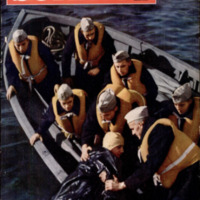 Popular Science Monthly, v. 142, n. 3, 1943
Popular Science Monthly, v. 142, n. 3, 1943

